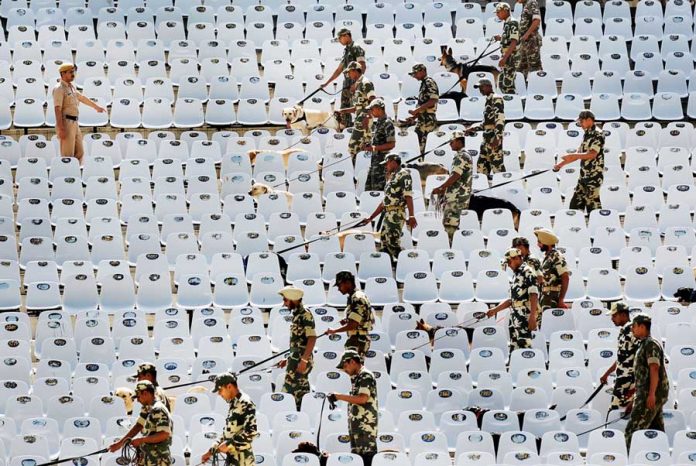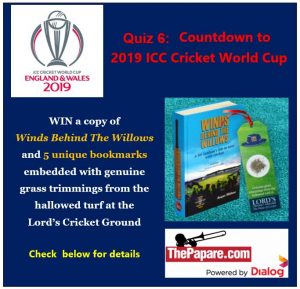
Halfway through the post-match presentation, Jagath and I hurried off. A quick shower and change, then straight to the Bandaranaike International Airport – destination India. We headed for the second semi-final on the following day and the final a few days later.
The 3.20 am flight landed in Chennai at 4.40 am. Bypassing long snaking lines, courtesy of an airport official, we practically ran through immigration and customs. Having only carry-on baggage was a blessing. Our connecting flight to Chandigarh was at 6.30 am, for live action at the epic India–Pakistan semi-final clash in Mohali. No doubt an opportunity of a lifetime, we were filled to the brim with excitement.
We reached the boarding gate at 5.54 am, and I let out a deep sigh. Minutes later, seeing no one boarding, I asked Jagath, ‘What’s the boarding time?’
He sarcastically said, ‘These domestic flights are like private buses back home, machan. You can jump onto the footboard just before take-off!’
Unlike me, he’d been to India many a time. Nevertheless, I said that our flight number was not displayed anywhere.
We enquired from the gate agent, who curtly said, ‘The gate was closed at 6.00 am.’
Interrupting Jagath, who started to explain – ‘Look, we have to catch this flight…’ – I pointed to the clock that hung nearby and said, ‘Your time is 5.59 am. We came to India for something special, which millions of cricket fans can only dream of.’
To our utter dismay, he rudely brushed aside our humble pleadings by saying, ‘I can’t help you, that’s it,’ though he was only a call away from his walkie-talkie to get us on board the shuttle bus.
Jagath remarked later, ‘It certainly was a case of a spoilsport’s “who are you to enjoy all these privileges” attitude, if you get what I mean.’
We twiddled our thumbs for six hours before boarding the next available connection and reached Chandigarh Airport an hour after the match started. Leaving the bags at the hotel in the city, it was as late as 4.45 pm when we joined the line to enter the ground. At the first security frisk, Jagath’s eyes widened when the police officer threw away his 4-inch plastic comb. Though my green T-shirt with the Australian cricket crest had a somewhat ‘neutral’ appearance, I smelled trouble from the word go.
Checking my identity papers, the officer suspiciously asked, ‘Ah … British passport! From Sri Lanka, eh?’
After a long walk due to traffic restrictions near the stadium and three security checks, exhausted, we finally made it inside. Operational since 1993, the Punjab Cricket Association’s Stadium at Mohali is on the outskirts of Chandigarh. It had a reputation of being a world-class venue. At first glance, its unconventional floodlights – very low lighting pillars – seem distinctive. The reason is to prevent aircraft from the nearby Chandigarh airport colliding with them. The negative effect of low lights has somewhat been mitigated by the installation of as many as sixteen floodlights.
The high-voltage match between arch-rivals and warring neighbours was a catalyst for cricket diplomacy. The Indian prime minister Dr Manmohan Singh, his Pakistan counterpart Yousuf Raza Gilani, Sonia and Rahul Gandhi, and a host of other dignitaries were in attendance. The venue resembled a fortress, with hundreds of security personnel deployed both inside and outside the stadium. Tickets were at a premium. It was said that even the Delhi chief minister, Sheila Dikshit, failed to procure a ticket to the game. Reportedly, on the black market, the asking rate was exceeding INR 100,000 for a ticket.
The stadium had many more thousands inside than its 28,000 capacity. Weaving our way through a flood of passionate spectators, we reached our stand, the Pavilion Terrace.
Seeing that all the seats had been occupied and many spectators were standing, I asked Jagath, ‘How do we locate our seats?’
Knowing that I hated to watch games standing, he remained silent.
Feeling helpless but realising that it was not the ideal time to create a scene, as Sachin Tendulkar was batting, I moved away.
Other than sitting on the aisle steps, the only available space was on the platform adjoining the terrace. As I went there, many policemen – virtually all of them Sikhs – were watching the game from the platform. Tiptoeing to extend my height beyond 5 foot 11 inches, I managed to see flashes of the action through a sea of turbans. Just as my knees were beginning to feel wobbly and unstable, the first innings ended.

Minutes later, somebody tried to remove my shoulder bag from behind. I looked back and got the shock of my life. A coterie of police officers had surrounded me in the middle of the stand. I stood up without a word. A senior officer took my bag and examined its contents, including the wallet that was inside. In a degrading manner, he removed the items one by one and then held them high for public view. The bag search was followed by a frisk, the fourth one in a matter of a couple of hours. I was fuming inside. Just to give an idea, the size of the bag was only 10” x 8” x 2”.
To make matters worse, after checking my ticket, the officer said quite authoritatively, as if to a kindergartener, ‘You can’t sit on the aisle steps.’
I retorted, my annoyance clear, ‘Then show me my seat,’ and my words went in search of non-existent eardrums. ‘Look, I have a ticket for this stand and even the aisle steps are overflowing,’ I continued quite loudly to a disinterested individual.
His arrogant and humiliating action made me glare at him and bare my teeth. Fortunately, saner counsel prevailed; I avoided being labelled a terrorist. It would have had far-reaching consequences.
Taking a few deep breaths to get my bearings back, I thanked God. My instincts told me to get out of the ground as quickly as possible. After a mobile phone call to Jagath, and despite his request to stay on, I took off. I couldn’t remember even the name of the hotel we were booked into, but the habit of carrying hotel business cards on overseas travels came in handy. Back in the hotel, I had a glass and a half of Old Monk rum. Feeling relieved, I watched the dying moments of the game, which I had been forced to abandon at the venue, now on TV. It was a truly unmatched World Cup experience for me.
I learnt the lesson of the day: in Indian stadiums, your ticket is valid for the specified stand, situated at a stated level. Seat reservation ends there. Hence, spectators follow the first-come-best-view method for seat allocation.
India, meanwhile, won by 29 runs the match that mass-produced hysteria on both sides of the border and brought both countries to a standstill. Pakistan were restricted to just 231 runs in 49.5 overs. It was India’s first semi-final triumph on Indian soil, having lost to England in 1987 and Sri Lanka in 1996. Tendulkar, who was dropped four times, scored 85 runs and was awarded the Player of the Match. Pakistan’s Kamran Akmal became the third wicketkeeper to effect four stumpings in a World Cup tournament, joining Kumar Sangakkara and Mushfiqur Rahim. India booked their place in the final against Sri Lanka.
MailOnline (website of the UK’s Daily Mail) on 9 November 2012 carried an explosive extract from a book, on the match:
Ed Hawkins – a sports-betting journalist who had spent months investigating corruption in cricket – was following the game on TV at home in London with a friend. India batted first…
But as their innings was coming to an end, Hawkins received a tweet from an Indian bookmaker called Parthiv, a contact he had established during his investigations.
The tweet he received would cast doubt on the probity of one of the most famous one-day games of all time. In an extract from his new book, Bookie, Gambler, Fixer, Spy, Hawkins takes up the story…
‘With the innings winding down and my friend Cherrene off making more tea, I check emails, news sites, Facebook and, finally, my Twitter account. Parthiv had sent a message:
Bookie update … India will bat first and score over 260, 3 wickets fall within the first 15 overs, pak will cruise to 100, then lose 2 quick wickets, at 150 they will be 5 down and crumble and lose by a margin of over 20 runs.’
(Adapted from ‘Winds Behind The Willows’.)
QUIZ 8: Countdown to 2019 ICC Cricket World Cup
Win a copy of ‘Winds Behind The Willows’ and 5 unique bookmarks embedded with genuine grass trimmings from the hallowed turf at the Lord’s Cricket Ground.
All you have to do to is to answer the question below correctly, the winners to be selected from the correct entries received up to 1200 GMT on 28 February 2019.
Only one answer per email address is permitted. Winners will be notified by email.



















